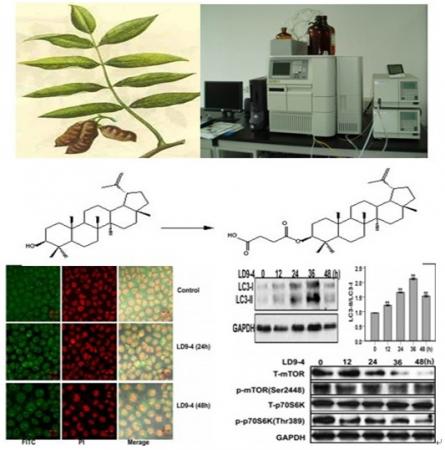在国家自然科学基金和科技部“新药创制”国家重大科技专项资助下,中科院华南植物园天然产物药物化学研究组在抗癌天然产物的发现和作用机制方面取得新的研究成果。

自噬在肿瘤细胞中发挥何种作用学术界一直存在争议。近期研究表明,自噬可以导致肿瘤细胞死亡,因而成为抗癌药物的热点。花榈木(Ormosia henryi Prain)是一种广泛用于癌症疼痛及骨流失疾病治疗的中草药。研究组从中分离鉴定出23个化合物,包括1个结构新颖的多异戊烯基取代的异黄烷,它在体外表现出很强的抑制A549肿瘤细胞增殖的活性。随后,对花榈木的活性成分及其半合成衍生物的抗癌作用机制进行深入研究,发现其通过诱导“自噬”(autophagy)而导致癌细胞死亡,这与传统抗癌药物诱导细胞凋亡的作用机制不同。这些化合物正是通过产生活性氧自由基破坏线粒体,引起内质网应激,最终导致细胞自噬死亡。
目前基于凋亡机制的抗癌药物由于过量使用而产生的普遍“耐药性”已引起医药界广泛关注,而诱导自噬的抗癌药物才刚刚兴起,一旦通过临床试验获准上市,无论是单独使用或与凋亡类抗癌药联合使用,将可大大减少耐药性而增强疗效。花榈木“自噬”抗癌活性成分的发现,为抗癌药物的研究提供了一个新思路。
该研究成果是在邱声祥研究员指导下,由博士研究生冯世秀、郝静以及博士后李伟杰等共同完成。目前相关研究成果已发表在国际期刊European Journal of Pharmacology(2011, 670: 29-38)和Fitoterapia(Doi:10.1016/j/fitote.2011.10.007)上。
相关英文论文摘要:
Autophagy is induced by 3β-O-succinyl-lupeol (LD9-4) in A549 cells via up-regulation of Beclin 1 and down-regulation mTOR pathway
The purpose of this study is to investigate the antitumor activity of a new derivative of lupeol-3β-O-succinyl-lupeol (LD9-4) and the molecular mechanism underlying cell death in human non-small cell lung cancer A549 cells. The results revealed that LD9-4 inhibited A549 cell proliferation in a time- and dose-dependent manner, with an IC50 value of 5.78±0.48μM after cells exposed to LD9-4 for 72h. Markers indicative of apoptosis (cell cycle arrest, phosphatidylserine externalization and Hoechst33258 staining) were uniformly negative in LD9-4 exposed cells. Interestingly, transmission electron microscope, MDC staining and LC3 level determination all confirmed that autophagy was induced in LD9-4 treated A549 cells. Furthermore, we found that LD9-4-induced autophagy in A549 cells was associated with the increase of intracellular reactive oxygen species and the decrease of phosphorylated mTOR and p70S6K levels. In the meanwhile, both mRNA and protein levels of Beclin 1 were up-regulated in a time-dependent manner. Our data suggest that autophagy is induced by LD9-4 in A549 cells, and the accumulating reactive oxygen species, up-regulation of Beclin 1 and inhibition of the mTOR signaling pathway are involved in this process.
英文论文链接:https://journals2.scholarsportal.info/details.xqy?uri=/00142999/v670i0001/29_aiib3ib1admp.xml







